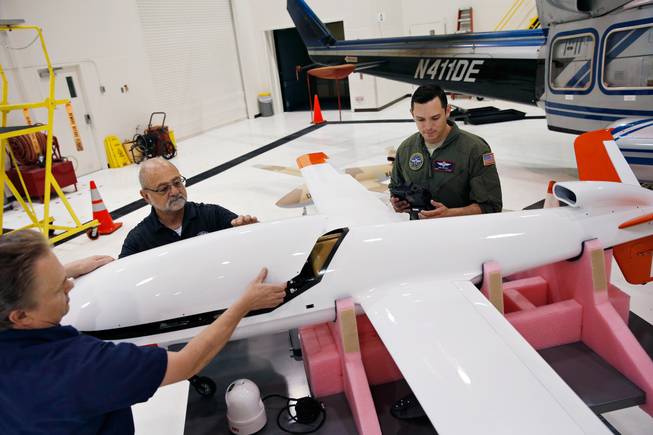
John Locher / AP
From left, Joe Cummings, Mike Lukens and Mike Toland of National Security Technologies, a contractor for the National Nuclear Security Administration, work on a drone May 19, 2016, at the Remote Sensing Laboratory in Las Vegas. Officials from the Nevada National Security Site announced the purchase of two unmanned aerial vehicles as part of a test program to provide arial radiological monitoring in the event of an emergency.
Monday, May 23, 2016 | 2 a.m.
If there's ever a radiological catastrophe in the U.S. like the 2011 Fukushima disaster in Japan, the stewards of the former national nuclear weapons proving ground in Nevada expect to be ready to deploy remote-controlled drones to check for contamination.
Nevada National Security Site officials have purchased two unmanned aerial vehicles to sniff the sky and provide an eye from above in the event of an emergency.
The idea, said Jim Holt, president of site contractor National Security Technologies, is to use pilotless aircraft "in situations where manned aircraft may not be used safely."
The airplanes will be tested in coming months over a secure federal reservation north of Las Vegas with a goal of being ready to be sent elsewhere if needed.
"We're evolving," said Karen McCall, drone program manager for National Security Technologies, the company that manages the area for the U.S. Energy Department's National Nuclear Security Administration. At 1,360 square miles, it's almost the size of Long Island, New York.
Formerly known as the Nevada Test Site, the area is now used for security and emergency response training, national security and defense experiments, and nuclear weapons stockpile maintenance.
Seven people — including remote-controllers, engineers and mechanics — are training to have the unmanned aerial systems program up and flying this fall, McCall said.
The team already uses a Bell 412 helicopter and a Beechcraft King Air twin-engine airplane based at Nellis Air Force Base for aerial radiological monitoring.
Team members left the aircraft in Nevada but took monitoring equipment to Japan for helicopter and fixed-wing aircraft surveys near the burning Fukushima Daiichi reactors after the March 2011 earthquake and tsunami.
The two Sandstorm drones are expected to upgrade gamma ray remote sensing, photos, environmental monitoring and site security.
The drones were acquired from Unmanned Systems Inc., a company based in nearby Henderson, under a one-year, $240,000 contract that includes training, service, and maintenance.
The turbine-driven propeller aircraft has an 8-foot fuselage, a 15-foot wingspan and weighs 44 pounds. It can carry another 20 pounds of sensors and cameras, company executive Bill Reynolds said.
The company does its testing at a facility in Kalispell, Montana. Reynolds noted that the Sandstorm was certified by the Federal Aviation Administration in 2010.
In recent years, drone programs have developed to spray crops, inspect power lines, collect seismic data and provide an eye in the sky to news crews and police.
Officials noted that Nevada was picked in December 2013 as one of six states for FAA-authorized testing of what officials officially call unmanned aerial systems. Alaska, New York, North Dakota, Texas and Virginia were others. The program in the Silver State is anchored by the Nevada Institute for Automatous Systems.

Join the Discussion:
Check this out for a full explanation of our conversion to the LiveFyre commenting system and instructions on how to sign up for an account.
Full comments policy